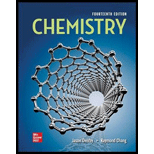
Concept explainers
The molecules cis-dichloroethylene and trans-dichloroethylene shown in Section 10.2 can be interconverted by heating or irradiation. (a) Starting with cis-dichloroethylene, show that rotating the C═C bond by 180° will break only the pi bond but will leave the sigma bond intact. Explain the formation of trans-dichloroethylene from this process. (Treat the rotation as two stepwise 90° rotations.) (b) Account for the difference in the bond enthalpies for the pi bond (about 270 kJ/mol) and the sigma bond (about 350 kJ/mol). (c) Calculate the longest
(a)
Interpretation:
In 1,2-dichloroethylene,while rotating the
Concept Introduction:
Rotation of 1,2-dichloroethylene:
1,2-dichloroethylene has two distinct isomers such as cis- and trans- isomers. The double bond between the two carbon atoms will have one sigma bond and one pi- bond. During
Explanation of Solution
It is known that sigma bond is formed by end-to-end overlap. So, rotation about
(b)
Interpretation: The difference in the bond enthalpies for the pi and the sigma bond has to be accounted.
Concept Introduction:
Bond enthalpy is the amount of energy required to break one mole of a particular type of bond. Hence, bond enthalpy decides the bond strength.
Trends of bond enthalpy:
The larger bond enthalpy value for a type of bond means that the bond requires more energy for breaking it which implies that the particular bond is being a strong bond. Whereas the smaller bond enthalpy value for a type of bond means that the bond requires less energy for breaking it which implies that the particular bond is being a weak bond.
Explanation of Solution
The bond enthalpy for the sigma bond is given as
The bond enthalpy for the pi bond is given as
Clearly, the bond enthalpy value of sigma bond is being higher than that of the pi bond. This difference in the bond enthalpy implies the difference in the bond strength. From this information it can be concluded that sigma bond is stronger bond whereas pi-bond is weaker bond. It is known that sigma bond is formed by end-to-end overlap whereas pi-bond is formed by sideways overlap. The extent of the sideways overlap is less than the end-to-end overlap. Hence, pi-bond is weaker than the sigma bond.
(c)
Interpretation:
In the conversion 1,2-dichloroethylene from cis- to trans-form, the longest wavelength of light needed to bring about the conversion, has to be calculated.
Concept Introduction:
In 1,2-dichloroethylene , conversion from cis- to trans- can be achieved by the rotation of the double bond for about
Rotation of 1,2-dichloroethylene:
1,2-dichloroethylene has two distinct isomers such as cis- and trans- isomers. The double bond between the two carbon atoms will have one sigma bond and one pi- bond. During
The longest wavelength of light needed to bring about the conversion, can be calculated using the formula shown below:
Answer to Problem 10.108QP
The longest wavelength of light that is needed for the isomeric conversion of 1,2-dichloroethylene is
Explanation of Solution
For the conversion from cis- to trans-form in 1,2-dichloroethylene, it is known that only the breaking of pi-bond brings the conversion. The bond enthalpy value of pi-bond is the amount of energy required to break the pi-bond. The bond enthalpy value of pi-bond is
Converting the bond enthalpy value from
Converting the bond enthalpy value from
This is the energy required to for the conversion of cis-to trans-form in one molecule. The wavelength corresponding to this energy can be calculated using the formula as follows:
Substituting all the known values in the formula and evaluating it:
Converting the wavelength from meter into nanometre:
Therefore,
The longest wavelength of light that is needed for the isomeric conversion of 1,2-dichloroethylene, has been calculated.
Want to see more full solutions like this?
Chapter 10 Solutions
Chemistry
- What is the final product when D-galactose reacts with hydroxylamine?arrow_forwardIndicate the formula of the product obtained by reacting methyl 5-chloro-5-oxopentanoate with 1 mole of 4-penten-1-ylmagnesium bromide.arrow_forwardIn the two chair conformations of glucose, the most stable is the one with all the OH groups in the equatorial position. Is this correct?arrow_forward
- please help me with my homeworkarrow_forwardhelparrow_forwardThe temperature on a sample of pure X held at 1.25 atm and -54. °C is increased until the sample boils. The temperature is then held constant and the pressure is decreased by 0.42 atm. On the phase diagram below draw a path that shows this set of changes. pressure (atm) 2 0 0 200 400 temperature (K) Xarrow_forward
- QUESTION: Answer Question 5: 'Calculating standard error of regression' STEP 1 by filling in all the empty green boxes *The values are all provided in the photo attached*arrow_forwardpressure (atm) 3 The pressure on a sample of pure X held at 47. °C and 0.88 atm is increased until the sample condenses. The pressure is then held constant and the temperature is decreased by 82. °C. On the phase diagram below draw a path that shows this set of changes. 0 0 200 temperature (K) 400 аarrow_forwarder your payment details | bar xb Home | bartleby x + aleksogi/x/isl.exe/1o u-lgNskr7j8P3jH-1Qs_pBanHhviTCeeBZbufuBYT0Hz7m7D3ZcW81NC1d8Kzb4srFik1OUFhKMUXzhGpw7k1 O States of Matter Sketching a described thermodynamic change on a phase diagram 0/5 The pressure on a sample of pure X held at 47. °C and 0.88 atm is increased until the sample condenses. The pressure is then held constant and the temperature is decreased by 82. °C. On the phase diagram below draw a path that shows this set of changes. pressure (atm) 1 3- 0- 0 200 Explanation Check temperature (K) 400 X Q Search L G 2025 McGraw Hill LLC. All Rights Reserved Terms of Use Privacy Cearrow_forward
- Chemistry: Matter and ChangeChemistryISBN:9780078746376Author:Dinah Zike, Laurel Dingrando, Nicholas Hainen, Cheryl WistromPublisher:Glencoe/McGraw-Hill School Pub Co
 Chemistry: The Molecular ScienceChemistryISBN:9781285199047Author:John W. Moore, Conrad L. StanitskiPublisher:Cengage Learning
Chemistry: The Molecular ScienceChemistryISBN:9781285199047Author:John W. Moore, Conrad L. StanitskiPublisher:Cengage Learning

